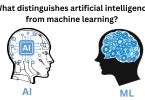Introduction: By enabling computers to learn and improve from data without explicit programming, machine learning has transformed several sectors. The importance, functionality, and various types of machine learning are highlighted in this article’s overview.
Machine learning?
A branch of artificial intelligence (AI) known as “machine learning” is devoted to creating models and algorithms that enable computers to learn from experience and make judgments or predictions based on information. To produce precise predictions or act on brand-new, unforeseen data, models must be trained with current data.
What Is the Importance of Machine Learning?
The following justifications support the importance of machine learning:
- Data-driven Insights: Machine learning enables businesses to glean useful information from massive amounts of data, resulting in better outcomes and decision-making.
- Automation and Efficiency: Machine learning improves efficiency, decreases human error, and saves time by automating routine operations and procedures.
- Personalization: Machine learning algorithms examine user preferences, behavior, and patterns to present individualized suggestions, goods, and experiences.
- Predictive Capabilities: Machine learning models predict future trends, spot abnormalities, and forecast results, enabling preemptive actions and risk reduction.
How Does Machine Learning Work?
Machine learning generally works like this:
- Data collection from pertinent sources is done to ensure the accuracy and relevance of the information for the given issue.
- Data is collected, cleaned, processed, and prepared to handle missing numbers, handle noise, and standardize formats.
- Exposing a machine learning model to input-output pairs while using the prepared data allows for model training. The data is used by the model to discover patterns, connections, and rules.
- Model Evaluation: Test data are used to assess the performance of the trained model and check for good generalization to new data.
- Model Deployment: Once the model performs to expectations, it is put into use in a production setting to make judgments or act in response to fresh data.
4. Categories of Machine Learning:
There are three basic categories for machine learning:
Supervised Learning: This type involves training the model using labeled data where the input and corresponding output are provided. The link between inputs and labeled outputs teaches the model how to make predictions.
Unsupervised Learning: In this case, unlabeled data are used to train the model. Without any specified outputs, the objective is to find patterns, clusters, or correlations in the data.
Reinforcement Learning: Training an agent to interact with the environment and learn through feedback or rewards is known as reinforcement learning. The agent acts in a way that maximizes overall rewards over time.
In today’s data-driven environment, machine learning is essential because it provides data-driven insights, automation, personalization, and predictive capabilities. Organizations may make use of machine learning’s ability to improve decision-making, streamline processes, and provide better user experiences by grasping its principles, including its significance, functionality, and types.








